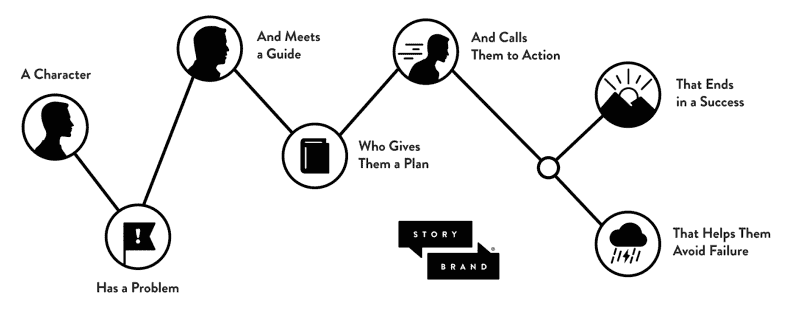
Why StoryBrand
I released increaser.org half a year ago. During this time, only 10% of visitors registered in the app. I wasn't satisfied with this result and decided to start research on what I can do to grow the percentage of registered users.
I started by reading “Building a StoryBrand”. The main message of this book is — by applying seven universal elements of powerful stories, we can dramatically improve how we connect with customers and grow our businesses. In a nutshell, the story looks like this: A CHARACTER who wants something encounters a PROBLEM before they can get it. At the peak of their despair, a GUIDE steps into their lives, gives them a PLAN, and CALLS THEM TO ACTION. That action helps them avoid FAILURE and ends in a SUCCESS.
While reading the book, you fill the document called BrandScript by answering particular questions that will describe your brand. Then you can use this document to create or update your marketing materials and website. In this article, we will fill StoryBrand BrandScript for Increaser. In the next part, I will show you how I changed Increaser's landing page by using BrandScript.
If you forget the basics of the book, here you can find the summary.
A Character
In the first part, we define our customers and what do they want as it relates to our product or service.
Increaser is an app for those who do deep work most of the time: students, engineers, programmers, mathematicians, and other technical workers. These peoples want to do more of uninterrupted, focused work, and less of shallow ones filled with distractions. This way, they will feel better and find time for activities they always wanted to do.
Has a Problem
In the second part, we are searching for a root cause of your customers’ problems and personify this root cause as a villain. Also, we answer what are the internal, external, and philosophical questions our customer deals with as it relates to our product or service.
Distraction and procrastination are the main villains when we talk about Increaser. Because of procrastination, we can’t produce a satisfying amount of deep work. Because of distractions, we feel stressed at the end of the day and don’t have time for things that matter to us.
External problem is “I need a productivity tracker with Pomodoro timer and statistics that works in the browser”.
Internal problem is “I want to work without stress and have satisfaction from work done”.
Philosophical problem is “I want to master the time and reach my goals”.
And Meets a Guide
In the third part, we show empathy by giving a brief sentence that expresses empathy, understanding, and authority by demonstrating competency in solving customer problems.
We understand how it feels like when there are a lot of things are going on, and you need to stay present and healthy while balancing all these responsibilities.
To show authority we show the number of users and testimonials.
Who Gives Them a Plan
In the fourth part, we list the steps our customers can take that would lead them to a sale or explain how they would use your product after the sale. Also, we list agreements we can make with our customers to alleviate their fears of doing business with us.
No payments are required. To start using the app, a user only need to sign up. Because of this, we will list after registration steps.
Steps:
-
Organize your life projects.
-
Start doing the work with the timer.
-
Analyze statistics and find the way to better use your time.
I thought carefully about the fear part but didn’t find anything to write here for Increaser. If you have any ideas, let me know!
And Calls Them to Action
In the fifth part, we decide what is our direct call to action will be and what transitional calls to action will we use to on-ramp customers.
In Increaser app call to action will be the “Sign Up” button. Simple as it can be.
That Helps Them Avoid Failure
In the sixth part, we list the negative consequences our customers will experience if they don’t use our product or service.
In the case of Increaser, I will write only one possible failure that looks for me like most important — “You may not find a time to work on your goals and ideas.”
And Ends in a Success
In the last part of the framework, we list the positive changes our customers will experience if they use our product or service.
The most important positive changes are:
-
Reach goals by doing more of what matters.
-
Reduce stress and live a happy life.
People Want Your Brand to Participate in Their Transformation
In the last part of the BrandScript, we write about how was our customers feeling about themselves before they used your product or service. And write about who will our customers become after they use our product or service.
Transformations:
-
From mediocre executor to senior level.
-
From person crying about having not enough time to the person that always finds time to what he wants to do.








